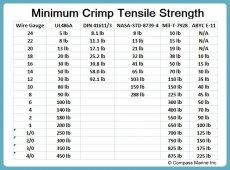Does anyone know or is there a way to test the quality of your crimp…?
i have about 70 to do this week for the wiring up my system, 4 ga to 4/0.
im using good quality everything , have practiced it a lot and have cut about 20 of the practice lugs in half to check the cold weld status .. I am trying to do it as good as possible ,but after you do them ,how do you really know, ( unless it’s an obvious screw up) ..I do a pull test , they look fine, but how do you know.?
is there a way to use a multi meter to evaluate resistance ( ( OHMS) before and after of the wire and lugs and whatever difference may exist before joining and after joining…
or is that even a meaningful test…
so much could show up as so many things with just one bad crimp being the culprit…
this ain’t cool…
there has to be a way to know more than just hoping it’s a good crimp..
But maybe I’m wrong…
thx ….Jim
I watched experts solve this issue 30 odd years ago... That 'Sloution' was at least 100 years old 30 years ago.
Build the joint, tension test the joint by pulling on it, then connect the joint, electrically load the joint and look for resistance expressed in heat.
Static electrical resistance testing (ohm meter on disconnected wire) ONLY detects conductor resistance per foot, and resistance of terminal ends.
You simply CAN NOT test the load carrying capabilities without a load test. It's that simple, and it's also the reason load testers exist.
Load that '200 Amp Capable' conductor at 200 Amps and you will get your answer rather quickly, if it DOESN'T heat up, it's carrying the load.
If it DOES heat up, you have issues somewhere because heat means FAILURE AT CAPACITY.
From the first DC grid systems (Edison) all heavy connections have been SILVER SOLDERED AFTER MECHANICAL CRIMP.
These generators are still in service today. See the NYC subway systems and other systems.
AC generators that have been in serves thst long also (Westinghouse-Tesla) do exactly the same thing. Mechanically clamp the conductors, silver solder the connections.
Fact. Silver conducts electrical current better, less resistance than copper. Copper is more common so cheaper.
This means copper is a compromise. Adding silver at critical connections LOWERS RESITANCE, PROMOTES ELECTRICAL CONDUCTION.
Fact. Silver Solder, and silver bearing electrical solder ONLY FILL AIR GAPS AFTER MECHANICAL CONNECTION.
Fact. Air gaps ARE NOT ELECTRICALLY CONDUCTIVE. Soldering with silver, high or low temp, turns gaps into conduction.
Fact. Silver solder (high or low temp) protects much more reactive copper from corrosion, impeded conduction.
Real Silver Solder takes temperatures the normal DIY type can't produce, it takes an oxygen fed torch or electro-magnetic induction heating to temperatures high enough for silver to flow.
Silver content, called silver content BEARING solder IS readily/commonly available and does lower temperature joints the same way. This is your soldering iron/jet torch lighter heat range.
Mechanical connection, THEN silver solder electrical connection, then environmental seal the connection, like glue lined heat shrink...
So, someone is going to spout the "Aircraft/Vibration No Solder" argument...
Application. Application. Application.
Exactly how hard do your solar panels get beaten? Did you mount them on a rock crusher so they see serious high cycle vibration? Do your batteries sit on top of a piston type earth packer? Does your battery do life support for 300+ people?
Comercial aircraft wiring is replaced on schedule, hours on the airframe. Are your battery cables replaced on hours of use or age schedule? Application!
The high amp, AC and DC generators see continuous use, in a vibration environment, for over 100 years.
The application is proven, the connection has been figured out, for over 100 years.



